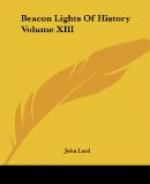Carlyle was now in what is called “high society,” and was “taking life easy,”—writing but little, yet reading much, especially about Oliver Cromwell, whose Life he thought of writing. His lectures at this period were more successful than ever, attended by great and fashionable people; and from them his chief income was derived.
While collecting materials for his Life of Cromwell, Carlyle became deeply interested in the movements of the Chartists, composed chiefly of working-men with socialistic tendencies. He was called a “radical,”—and he did believe in a radical reform of men’s lives, especially of the upper classes who showed but little sympathy for the poor. He was not satisfied with the Whigs, who believed that the Reform Bill would usher in a political millennium. He had more sympathy with the “conservative” Tories than the “liberal” Whigs; but his opinions were not acceptable to either of the great political parties. They alike distrusted him. Even Mill had a year before declined an article on the working classes for his Review, the Westminster. Carlyle took it to Lockhart of the Quarterly, but Lockhart was afraid to publish it. Mill, then about to leave the Westminster, wished to insert it as a final shout; but Carlyle declined, and in 1839 expanded his article into a book called “Chartism,” which was rapidly sold and loudly noticed. It gave but little satisfaction, however. It offended the conservatives by exposing sores that could not be healed, while on the other hand the radicals did not wish to be told that men were far from being equal,—that in fact they were very unequal; and that society could not be advanced by debating clubs or economical theories, but only by gifted individuals as instruments of Divine Providence, guiding mankind by their superior wisdom.
These views were expanded in a new course of lectures, on “Heroes and Hero Worship,” and subsequently printed,—the most able and suggestive of all Carlyle’s lectures, delivered in the spring of 1840 with great eclat. He never appeared on the platform again. Lecturing, as we have said, was not to his taste; he preferred to earn his living by his pen, and his writings had now begun to yield a comfortable support. He received on account of them L400 from America alone, thanks to the influence of his friend Emerson.
Carlyle now began to weary of the distraction of London life, and pined for the country. But his wife would not hear a word about it; she had had enough of the country, at Craigenputtock. Meanwhile preparations for the Life of Cromwell went on slowly, varied by visits to his relatives in Scotland, travels on the Continent, and interviews with distinguished men. His mind at this period (1842) was most occupied with the sad condition of the English people,—everywhere riots, disturbances, physical suffering and abject poverty among the masses, for the Corn Laws had not then been repealed; and to Carlyle’s vision there




